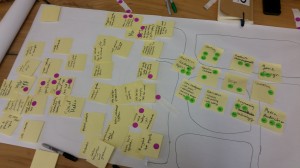When we met again with Vida Verde on Friday, 2/26 to discuss project ideas that would address co-op needs, we discovered that all of our ideas fell into three primary categories: Coordination, Product Sales, and Marketing.
Coordination includes all of the communications, organization, and management of the business. Currently, each step of client intake and cleaner scheduling and communication requires multiple steps of paperwork. After noting some of the primary concerns voiced in Yelp reviews, we found that language barriers and inconsistent communication were significant obstacles for clients who had hired or attempted to hire Vida Verde in the past. Can we automate this process? Can we make it easier for cleaners, coordinators, and clients to understand and respond to each other’s needs? Can Vida Verde function without hiring a new full-time coordinator? A project focused on coordination would bring together client/cleaner, client/coordinator, and coordinator/cleaner communication practices and reduce the burden on cleaners and coordinators to create and navigate forms and spreadsheets. Coordination on the VV end would also lead to a more convenient, seamless process for the client.
Our business canvas for a coordination-focused project: https://canvanizer.com/canvas/MY55Sea-epk
While a project focused on coordination would streamline VV’s current practices, a focus on natural cleaning product sales would take their business in a completely new direction. Currently, they believe one of their main value propositions is the all-natural, chemical-free products they use in their business. Is it possible that this value proposition is high enough that they could viably sell the products by themselves and host paid workshops on making the products at home? With this product idea, we would need to look into packaging, marketing for the product, distribution, and value propositions for the actual materials.
Our business canvas for a product sales-focused project: https://canvanizer.com/canvas/FGr9RxlEqoE
Marketing, if successful, would drive the expansion of the business and solve the most pressing issue facing Vida Verde. When VV first started, they had near-constant news coverage because of the social and environmental impulse behind creating the co-op. From this coverage, they got hundreds of clients and had a thriving cooperative of around 30 cleaners. After a devastating incident where several cleaners left the cooperative with their clients, VV has struggled to regain their former success. A focus on marketing would involve finding the best ways to get new clients, prototyping advertising strategies, doing outreach at events, testing different value propositions, and potentially expanding the referrals program.
Our business canvas for a marketing-focused project: https://canvanizer.com/canvas/EKywguzW28g

